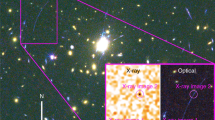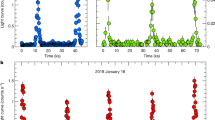Abstract
X-RAY emission from the dwarf nova SS Cygni was first detected at soft (∼ ¼ keV) X-ray wavelengths when the source was in an optical high state1–3. More recently, ANS satellite observers4 have reported the detection of soft X-ray emission when SS Cygni was in an optical low state. These latter observations show the flux of the soft X-ray source to be about an order of magnitude less than the values when in the optical high state. The soft X-ray positional uncertainty is ∼ 0.2deg2. The correlation between optical and soft X-ray behaviour convincingly identifies SS Cygni as a soft X-ray source. Hard ( > 1 keV) X-ray emission from a 15′ × 1.5° area containing SS Cygni was also reported by the ANS observers during the optical low state and identified with SS Cygni4. A more accurate position (0.03 deg2) has been reported by Ariel 5 observers5. We report here a 0.4 arc min2 measurement of the position of the X-ray source with the HEAO 1 modulation collimator experiment which leads to an unequivocal identification of SS Cygni as an X-ray emitter in the 2–10 keV energy range. We have also searched the Uhuru data to investigate the historical light curve in hard X rays.
This is a preview of subscription content, access via your institution
Access options
Subscribe to this journal
Receive 51 print issues and online access
$199.00 per year
only $3.90 per issue
Buy this article
- Purchase on Springer Link
- Instant access to full article PDF
Prices may be subject to local taxes which are calculated during checkout
Similar content being viewed by others
References
Rappaport, S., Cash, W., Doxsey, R., McClintock, J. & Moore, G. Astrophys. J. Lett. 187, L5 (1974).
Bowyer, S., Lampton, M., Paresce, F., Margon, B. & Steven, R. Bull. Am. Astr. Soc. 8, 447 (1976).
Hearn, D. R., Richardson, J. A. & Li, F. K. Bull Am. astr. Soc. 8, 447 (1976).
Heise, J. et al. Astr. Astrophys. 63, L1 (1978).
Ricketts, M. J., King, A. R. & Raine, D. J. Mon. Not. R. astr. Soc. (submitted).
Gursky, H. et al. Astrophys. J. (in the press).
Holm, A. V. & Gallagher, J. S. Astrophys. J. 192, 425 (1974).
Glasby, J. S. The Dwarf Novae (Constable, London 1970).
Robinson, E. L. Ann. Rev. Astr. Astrophys 14, 119 (1976).
Pringle, J. E. Mon. Not. R. astr. Soc. 178, 195 (1977).
Galeev, A. A., Rosner, R. R. & Vaiana, G. S. XXI COSPAR mtng (1978).
Fabian, A. C., Pringle, J. E. & Rees, M. J. Mon. Not. R. astr. Soc. 175, 43 (1976).
Author information
Authors and Affiliations
Rights and permissions
About this article
Cite this article
FABBIANO, G., GURSKY, H., SCHWARTZ, D. et al. SS Cygni as a hard X-ray source identified with the scanning modulation collimator on HEAO 1. Nature 275, 721–723 (1978). https://doi.org/10.1038/275721a0
Received:
Accepted:
Issue Date:
DOI: https://doi.org/10.1038/275721a0
This article is cited by
-
Multifrequency behayiour of the dwarf nova SS Cygni
Astrophysics and Space Science (1990)
-
The system AM Her = 4U 1814 + 50
Space Science Reviews (1980)
Comments
By submitting a comment you agree to abide by our Terms and Community Guidelines. If you find something abusive or that does not comply with our terms or guidelines please flag it as inappropriate.



